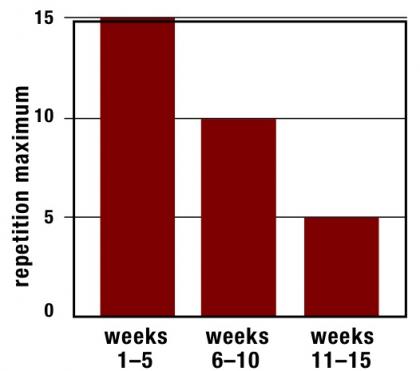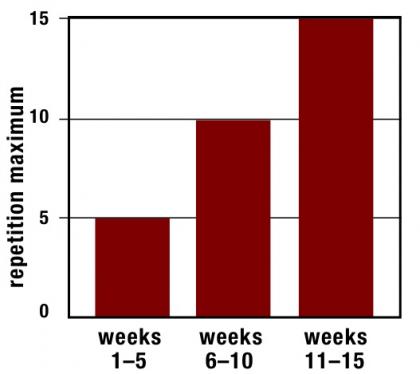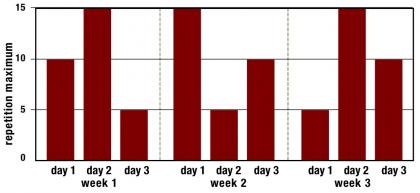Progression Models in Resistance Training for Healthy Adults
The updated 2009 American College of Sports Medicine position stand revealed.
The new report from the American College of Sports Medicine (ACSM) regarding progression models in resistance training for healthy adults adds to the previous 2002 position stand, which established a structure for guiding healthy adults to develop muscular fitness (i.e., muscular strength, hypertrophy, power and muscular endurance). This latest review defines and
establishes an all-inclusive framework for resistance training program design. For instance, the ACSM paper describes progression in resistance training as “the act of moving forward or advancing towards a specific goal over time until the target goal has been achieved.” Progressive overload
is “the gradual increase in stress placed upon the body during exercise training.” Resistance training maintenance depicts programs designed to maintain the current level of muscular fitness. A critical review of the guidelines for healthy adults follows.
Resistance Training Basics: Progressive Overload, Specificity and Variation
In order for the body to adapt to resistance training, an orderly approach to increasing the performance demands on the musculoskeletal system has to be initiated using one of the following strategies:
- Adding resistance training intensity (i.e., weight lifted) based on an absolute or relative (i.e., percent of repetition maximum, or 1 RM) weight. For instance, a client might be training at 70% of his 1 RM for an exercise and then progress to 73% of the 1 RM with the next overload in training.
- Completing more repetitions at the present level of exercise intensity. Thus, if a client is completing 10 reps with 100 pounds (lb) on an exercise, the progression may go to 12 reps with 100 lb.
- Altering the speed and/or tempo of repetitions (e.g., 2 seconds of concentric [shortening] followed by 4 seconds of eccentric [lengthening]).
- Changing the rest periods between multiple sets when training strength
(longer rests—e.g., 2–3 minutes); power (again, longer rests—e.g., 2–3 minutes); and endurance (shorter rests—e.g., 1–2 minutes). - Gradually increasing (2.5%–5%) the training volume (total number of repetitions completed multiplied by weight lifted). For example, 10 reps x 90 lb equals 900 lb lifted for an exercise. Increase this 900 lb training volume by 4%: 0.04 x 900 = 36 lb. The new training volume is 936 lb (900 lb + 36 lb), which can be completed with 10 reps x 94 lb (93.6 rounded up).
The authors of the new ACSM position stand emphasize that the most successful resistance training programs are those
designed toward target-specific training goals. Once the goals are identified, the program can be adjusted to improve performance aspects of the activity, such as movement speed, range of motion, muscle actions (concentric, eccentric, isometric), energy systems (phosphagen and/or glycolytic), intensity and volume.
Variation in resistance training is now best realized with periodization models of training. The research on periodization shows that, for long-term progression and improvement in muscular fitness, methodical variations in volume and intensity are the chief factors to alter. Linear periodization (see Figure 1) is characterized by a high initial volume stimulus with a low intensity. As the model progresses, volume decreases and intensity concurrently increases.
Reverse linear periodization (see Figure 2) describes a program design with a high initial intensity with a low volume. As the model progresses, intensity decreases and volume concurrently increases. This model has shown consequential improvements in muscular endurance.
Nonlinear (or undulating) periodization (see Figure 3) involves variation of volume and intensity within a shorter time period (i.e., a week as opposed to several weeks). The use of light (12–15 RM), moderate (8-10 RM) and heavy (3–5 RM) loads can be systematically or randomly (Figure 4) rotated. Nonlinear periodization has been shown to bring forth very positive muscular strength and endurance training outcomes. The new ACSM position stand points out that the benefits of periodiza-tion training are typically realized after 6 months of continuous training. Important to this type of training is assurance that
adequate recovery (24–48 hours between workouts, depending on the client’s fitness level) is incorporated into the program
design to avoid the effects of overtraining.
Resistance Training Program Design Variable Considerations
The 2009 ACSM position stand states that the results of a resistance training program depend on the type of program designed and the methodological manipulation of muscle actions, intensity, volume, exercise selection, exercise order, rest periods and workout frequency. Evidence-based guidelines of these acute variables for healthy adults are addressed below. Table 1 summarizes these variables for developing muscle hypertrophy.
Muscle Actions
Traditional resistance training programs primarily include concentric and eccentric dynamic exercise movements. Isometric (no change in muscle length) exercises are more associated with stabilization exercises, such as the isometric contraction in the
abdominals when doing a plank exercise. Isometric actions have notably been shown to be effective for improving low-back health, posture and spinal stabilization. Therefore, for all levels of fitness (novice,
intermediate and advanced), the 2009 ACSM position stand encourages the use of concentric, eccentric and isometric actions in the resistance training program design.
Intensity
The actual intensity (or load) needed to increase maximal strength is 45%–60% of 1 RM in untrained individuals. Progressively higher loads are required for moderately trained persons. Intensities of 80% and 85% of 1 RM are needed for optimal strength improvement in experienced lifters and athletes, respectively. Dynamic strength is markedly increased in repetition zones of 1–6 RM, with a 5–6 RM being the most meaningful. However, the variable-intensity loading scheme (i.e., 3–5 RM, 8–10 RM, 12–15 RM) employed in periodization programs appears to be the most advantageous for the progression and
enhancement of muscular strength.
Volume
Training volume can be modified by (1) changing the number of exercises performed in a workout, (2) varying the number of repetitions performed in a set and/or (3) increasing the number of sets per exercise. The new ACSM position stand indicates that novice lifters achieve similar gains in muscular fitness from single-set and multiple-set programs. For trained individuals, the research suggests that 3–4 sets elicit the most effective increases in strength. However, the report underscores that further increases in training volume may be counterproductive, possibly leading to overtraining. Therefore, for improvement in strength the variation of volume with intensity (as seen in periodization programs) is more important than the total number of sets.
Exercise Selection
Single-joint exercises (e.g., knee extension, triceps extension, biceps curl) and multiple-joint exercises (e.g., bench press, shoulder press, squat), performed unilaterally (alternating limbs) and bilaterally (both limbs simultaneously), should be included in resistance training program designs. The ACSM review paper affirms that multiple-joint exercises produce the best overall increases in strength in all lifters, whether they are novice, intermediate or advanced lifters.
Exercise Order
With novice, intermediate and advanced strength training enthusiasts, total-body workouts (all muscle groups trained in one session), upper/lower-body splits (upper body one day and lower body
another day) and agonist/antagonist muscle group splits represent a variety of exercise order strategies that can be used. According to the new position stand, research shows that multiple-joint exercises increase muscle strength more when they are performed in the early part of a workout (because the energy demands of these exercises are high).
Rest Periods
The length of rest periods should depend on the complexity of the movement (e.g., a squat versus a biceps curl) and the load being lifted (light versus heavy). That said, the 2009 ACSM position stand suggests that 2–3 minutes’ rest between multiple-set bouts is best for the muscle’s energy recovery needs (ATP resynthesis and removal of metabolic byproducts).
Muscle Action Velocity
For untrained individuals, a 2-second concentric followed by a 4-second eccentric (2:4) velocity of movement is recommended, as well as a 1-second concentric followed by a 2-second eccentric (1:2) velocity. For intermediate lifters, a 1:2 velocity is advocated; and for advanced lifters, ACSM proposes a variety of velocities, from fast to unintentionally slow (i.e., speed dictated by load of exercise to the lifter, and not a purposely slow repetition).
Frequency
For untrained lifters, the 2009 position stand recommends weight training the major muscles (total-body workout) 2–3 days per week. However, the authors clarify that the frequency of resistance training workouts may be particularly affected by the intensity and volume of each workout (and thus should be modified accordingly). For intermediate lifters, 3 days per week is satisfactory for total-body workouts, whereas 4 days per week is more adequate using a split model of training (training each major muscle twice in the week). Advanced lifters are capable of various combinations of split routines on 4–6 days per week.
Final Caveat
It is noteworthy to call attention to the
final message in the 2009 ACSM position statement. The authors assert that the
ultimate success of a resistance training program is the fitness professional’s ability to use good judgment, professional
experience, research findings, education and safety in helping clients reach their fitness and performance goals. We proudly accept this challenge!
muscle actions for novice, intermediate and advanced: concentric, eccentric and isometric
intensity and volume for novice and intermediate: 70%-85% of 1 RM; 8-12 repetitions for 1-3 sets per exercise
intensity and volume for advanced: 70%-100% of 1 RM; 1-12 reps (most in the 6-12 RM zone) for 3-6 sets per exercise in a periodized loading scheme
exercise selection and order for novice, intermediate and advanced: single- and multiple-joint exercises with energy-demanding multiple-joint exercises performed earlier in the workout
rest between multiple sets for novice and intermediate: 1- to 2-minute rest periods
rest between multiple sets for advanced: may vary from 1 to 3 minutes, depending on load and exercise goals
velocity of movement for novice and intermediate: slow to moderate
velocity of movement for advanced: slow, moderate and fast, depending on load, number of repetitions and exercise goals
frequency for novice: 2-3 days per week
frequency for intermediate: 4 days per week
frequency for advanced: 4-6 days per week
Len Kravitz, PhD
Len Kravitz, PhD is a professor and program coordinator of exercise science at the University of New Mexico where he recently received the Presidential Award of Distinction and the Outstanding Teacher of the Year award. In addition to being a 2016 inductee into the National Fitness Hall of Fame, Dr. Kravitz was awarded the Fitness Educator of the Year by the American Council on Exercise. Just recently, ACSM honored him with writing the 'Paper of the Year' for the ACSM Health and Fitness Journal.










